The stars in tonight’s sky form many familiar patterns that make their host constellations easy to identify. For observers in the northern hemisphere, the stars of the Winter Circle and the Winter Triangle dominate the evening sky. These seven first-magnitude stars – Sirius, Procyon, Rigel, Betelgeuse, Capella, Aldebaran, and Pollux – appear high above the eastern horizon, while Deneb and the rest of the Northern Cross set in the northwestern sky.
The three brightest stars in the sky are visible from the southern hemisphere in the evening. Sirius, Canopus, and Alpha Centauri appear in the eastern, southeastern, and southern sky respectively. Rigel, Betelgeuse, and Aldebaran rise in the northeast, and the stars of the Southern Cross – Acrux, Mimosa, Gacrux, Imai, and Ginan – appear low above the southern horizon. The Southern Pointers Alpha and Beta Centauri point towards Gacrux.
Procyon appears low in the eastern sky and Fomalhaut is high in the west. Achernar appears high overhead. It marks the end of the celestial River (Eridanus), which stretches all the way to Rigel in Orion.
The stars visible tonight depend on the observer’s location and the time of night. The star maps below show the first and second magnitude stars visible in the night sky around 10 pm in the mid-northern, equatorial, and mid-southern latitudes.
Northern hemisphere
Capella and Aldebaran are the brightest stars high overhead around 10 pm. Capella is the brightest star in Auriga (the Charioteer) and the sixth brightest star in the sky. It forms Auriga’s hexagon with Menkalinan, Mahasim, Hassaleh, and Almaaz in Auriga and Elnath in the neighbouring Taurus.
The stars of the hexagon can be used to find the bright open clusters Messier 36, Messier 37 and Messier 38, as well as the Flaming Star Nebula (IC 405), an emission and reflection nebula that surrounds the hot blue star AE Aurigae.
Aldebaran, the luminary of Taurus (the Bull), is the 14th brightest star in the sky. The giant star is part of the Bull’s Head, which is outlined by the bright, large Hyades cluster.
Aldebaran is not a member of the Hyades but it appears in the same field of view as the cluster. It marks one of the Bull’s eyes. The fainter Ain (Epsilon Tauri), one of the brightest Hyades stars, marks the other. Both stars are orange giants. Aldebaran lies 67 light-years away, while the more massive Ain is approximately 146 light-years away.
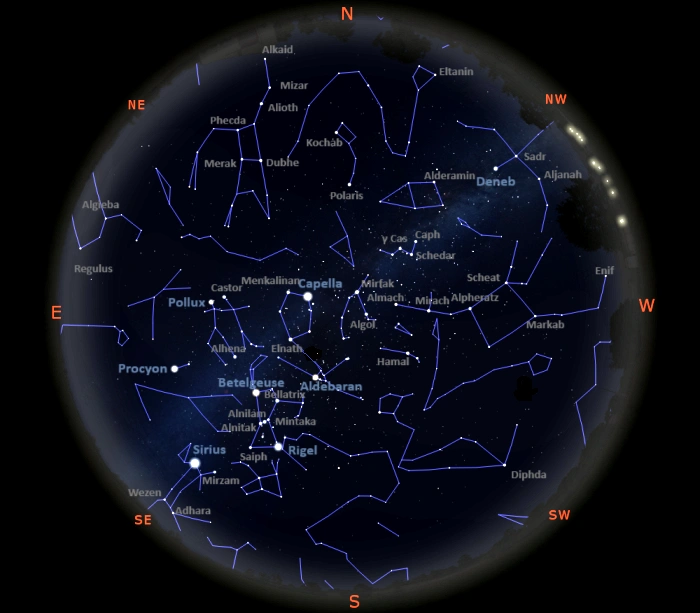
Stars visible tonight in the northern hemisphere, image: Stellarium
Stars in the northern sky
The brightest stars appearing directly north shine at second magnitude. Polaris, the North Star, marks the tip of the Little Bear’s tail and the end of the Little Dipper’s handle. It appears higher in the sky than the rest of the Little Dipper in the evening.
The Little Dipper asterism is difficult to make out in less-than-ideal conditions because its middle four stars are quite faint.
Kochab and Pherkad, the outer stars of the Dipper’s bowl, are relatively bright and appear parallel to Mizar and Alioth in the Big Dipper’s handle. Kochab and Pherkad are known as the Guardians of the Pole because they circle close to Polaris, the nearest visible star to the north celestial pole.
Polaris is on average only the 48th brightest star in the sky. Even though it is a supergiant star with a luminosity of 1,260 Suns, it lies 446.5 light-years away and appears as a second-magnitude star. The supergiant can be found by extending a line from Merak through Dubhe. The outer stars of the Big Dipper’s bowl point in the general direction of the North Star and are known as the Pointer Stars (or simply the Pointers).
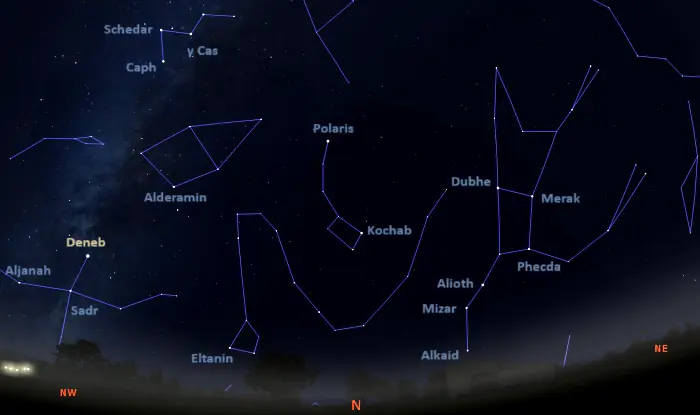
Stars in the northern sky tonight, image: Stellarium
The stars of the Big Dipper dominate the northeastern sky. Alkaid, the star at the tip of the Dipper’s handle, appears the closest to the horizon, while Merak and Dubhe are higher in the sky in the evening.
Six of the seven Big Dipper stars shine at second magnitude. Only Megrez, one of the inner stars of the Dipper’s bowl, is slightly fainter. Alioth, the brightest star in Ursa Major, has an apparent magnitude of 1.77, while Megrez shines at magnitude 3.312.
Five stars of the Big Dipper – Mizar, Alioth, Megrez, Phecda, and Merak – belong to the same family, the Ursa Major moving group. They were formed in the same stellar nursery at about the same time, and they share a common motion through space.
The region between the Big and Little Dippers is occupied by the fainter stars of Draco. The Dragon’s tail appears between the Dippers and the rest of its body winds around the Little Dipper towards the constellations Cepheus and Cygnus.
The Dragon’s head is formed by four relatively bright stars – Eltanin, Rastaban, Grumium, and Kuma – that appear low above the northern horizon around 10 pm. Eltanin and Rastaban, the stars that mark the Dragon’s eyes, can be found by extending a line through the beam of the brighter Northern Cross in Cygnus (the Swan). The Northern Cross appears low in the northwestern sky.
The stars of Cepheus (the King) and Cassiopeia (the Queen) appear higher above the northwestern horizon. Cassiopeia’s W appears like an M. A line extended from its brightest stars, Schedar and Caph, leads to Alderamin, the lucida of Cepheus.
Stars in the eastern sky
The brightest stars in the eastern sky in the evening are Procyon, Pollux, and Regulus. The bright stars of Orion are prominent in the southeastern sky. A line extended through the Belt of Orion points towards Sirius, the luminary of Canis Major (the Great Dog) and the brightest star in the sky.
Procyon is the brightest star in Canis Minor (the Little Dog) and the eighth brightest star in the sky. It forms an asterism known as the Winter Triangle with Sirius and Betelgeuse. Procyon and Sirius are among our nearest neighbours. Sirius lies 8.61 light-years away and Procyon is 11.46 light-years away.
The lucidae of the two dog constellations are part of the Winter Circle, a bright, large asterism also formed by Rigel in Orion, Aldebaran in Taurus, Capella in Auriga, and Pollux in Gemini.
Pollux and the slightly fainter Castor mark the heads of the celestial Twins. The two stars lie almost exactly east around 10 pm. Even though Pollux and Castor appear similar in brightness and colour, they are in fact very different. Pollux is an evolved K-type giant located 33.78 light-years away, while Castor is a sextuple star system located about 49.15 light-years away. Pollux and Castor are the 17th and 23rd brightest stars in the sky.
The zodiac constellation Leo rises in the east in the evening. Its brightest star, Regulus, is a hot blue subgiant star located 79.3 light-years away. It is the faintest of the 21 first magnitude stars. It appears at the base of an asterism called the Sickle of Leo. The Sickle looks like a backwards question mark and outlines the celestial Lion’s head and mane. Regulus marks the Lion’s heart.
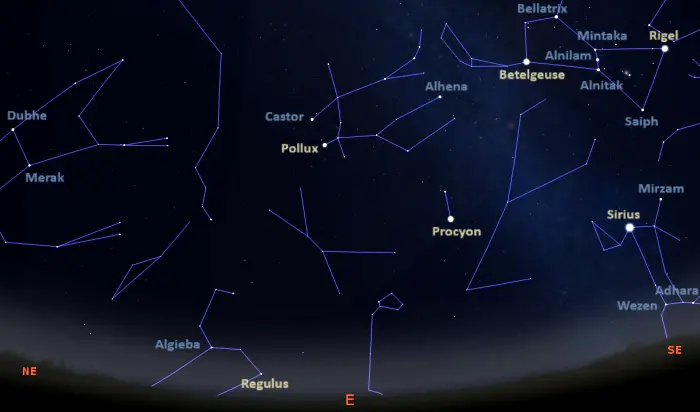
Stars in the eastern sky tonight, image: Stellarium
Stars in the western sky
The brightest stars above the western horizon belong to the constellation Pegasus. The supergiant Enif, the constellation’s brightest star, sets in the west around 10 pm. It marks the nose of Pegasus. Scheat, Markab and Algenib form the Great Square of Pegasus with Alpheratz in the neighbouring Andromeda. The asterism represents the body of the mythical horse.
Diphda at the tail of Cetus (the Sea Monster) appears low in the southwest, while the bright stars of the Northern Cross in Cygnus stand out in the northwestern sky.
Deneb, the star at the top of Northern Cross, is the most luminous and by far the most distant first-magnitude star. It has a luminosity 196,000 times that of the Sun and shines at magnitude 1.25 from a distance of 2,615 light-years. With 15 -19 times the Sun’s mass, the supergiant star is destined to go out as a supernova.
Its Northern Cross neighbour Sadr, another supergiant, is also a supernova candidate. It has a mass 14.5 times that of the Sun and lies approximately 1,800 light-years away.
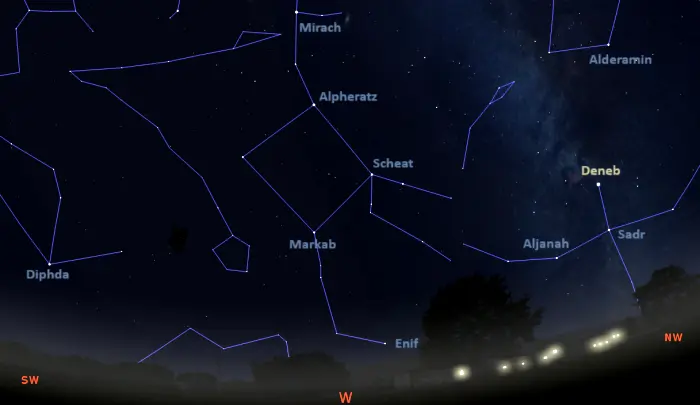
Stars in the western sky tonight, image: Stellarium
Stars in the southern sky
While there aren’t any exceptionally bright stars appearing directly south in the evening, the southeastern sky hosts about a dozen first and second magnitude stars.
The seven bright stars that outline the hourglass constellation figure of Orion are easy to spot even from light-polluted areas. The supergiants Rigel and Betelgeuse are the seventh and 10th brightest stars in the sky.
Betelgeuse and Bellatrix mark the Hunter’s shoulders, and Rigel and Saiph, his knees (or feet). Alnitak, Alnilam and Mintaka form the Belt of Orion, one of the most recognizable asterisms in the sky.
The three stars of Orion’s Belt are exceptionally hot, massive O- and B-type stars. Alnitak, the leftmost star, is a multiple star system whose primary component is an O-type supergiant with a mass 33 times that of the Sun. It lies approximately 1,260 light-years away. Mintaka is also a multiple star system composed of an O-type bright giant and several other hot blue components. The system lies 1,200 light-years away.
Alnilam, the central star of Orion’s Belt, is a hot, luminous B-type supergiant located approximately 1,250 light-years away. It has a luminosity 271,000 times that of the Sun .
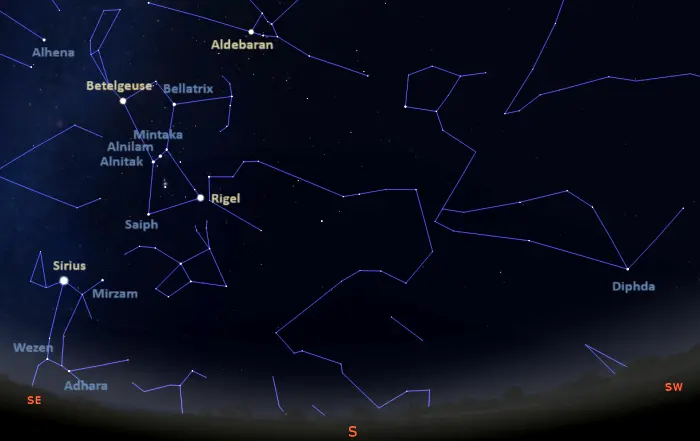
Stars in the southern sky tonight, image: Stellarium
A line drawn through Orion’s Belt leads to Sirius, the Dog Star. The brightest star in the sky lies only 8.61 light-years away. Even though it appears so bright primarily because it is close by, Sirius has twice the Sun’s mass and 24.7 times its luminosity. It is one of the most luminous stars in the solar neighbourhood.
Its fainter neighbour Mirzam is much more distant. It lies 490 light-years away and shines with a luminosity of 25,700 Suns. About four million years ago, the hot blue giant was the brightest star in the Earth’s sky. It was seven times brighter than Sirius is today and shone at magnitude -3.65. Today, Mirzam has an apparent magnitude of 1.985 and is on average the 46th brightest star in the sky, slightly outshining Polaris.
Three stars that rise in the southeast in the evening complete the brighter portion of Canis Major. Adhara, Wezen and Aludra form a triangle near Sirius. They are all hot, evolved stars destined to go out as supernovae.
Adhara, the constellation’s second brightest star, is a B-type giant with a mass 13.1 times that of the Sun. It lies 405 light-years away. Wezen is an F-type supergiant located approximately 1,600 light-years away. It has 16.9 times the Sun’s mass and 82,000 times its luminosity. Aludra is a B-type supergiant approximately 2,000 light-years away. It has a mass of 5.5 or 9.5 solar masses and shines with 163,800 solar luminosities.
The sky directly south is occupied by the relatively faint stars of Eridanus (the River). Other than Achernar, which is largely invisible to northern observers, the constellation does not contain any first or second magnitude stars.
Cetus (the Sea Monster) occupies much of the southwestern sky. Even though it is one of the largest constellations, it does not particularly stand out. The constellation’s brightest star, the orange giant Diphda, appears low above the southwestern horizon and is part of the Sea Monster’s tail.
Equatorial latitudes
The brightest stars high overhead in the evening are the orange giant Aldebaran, the brightest star in Taurus (the Bull), and the blue supergiant Rigel, the luminary of Orion (the Hunter).
Aldebaran appears as the brightest member of the Hyades, a bright, V-shaped open cluster that marks the Bull’s head. The giant star lies much closer to us than the cluster and is not a member. Shining at magnitude 0.86, Aldebaran is the 14th brightest star in the sky.
Rigel marks the foot or knee of Orion. It shines at magnitude 0.13 from a distance of 848 light-years. With a mass 21 times that of the Sun, hot blue supergiant is one of the brightest supernova candidates in the sky. It forms the familiar hourglass figure of Orion with several other supernova candidates: the red supergiant Betelgeuse, blue supergiant Saiph, and the three massive stars that form Orion’s Belt, Alnitak, Alnilam, and Mintaka.
None of the seven stars are fainter than second magnitude. Bellatrix at Orion’s shoulder is the only one of Orion’s seven brightest stars that may not go out as a supernova.
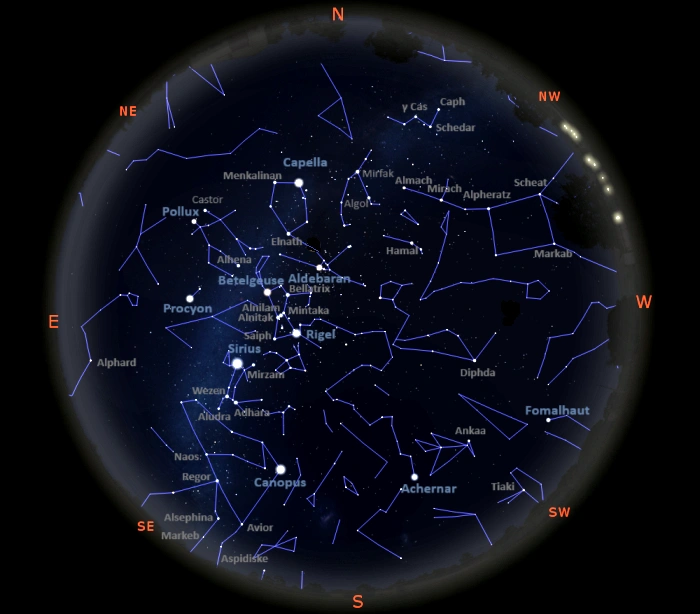
Stars visible tonight in equatorial latitudes, image: Stellarium
Northern sky
The brightest star in the northern sky is Capella, the luminary of Auriga (the Charioteer) and the sixth brightest star in the sky. It is the only first-magnitude star above the northern horizon in the evening.
Capella is part of the hexagon of Auriga, a conspicuous asterism formed by the brightest stars in Auriga with Elnath at the northern horn of the Bull (Taurus). The stars of Auriga appear high in the northern and northeastern sky around 10 pm.
The supergiant Mirfak and the famous variable star Algol appear above the northern horizon. They are the brightest stars in the constellation Perseus. Mirfak is the central star in the Alpha Persei Cluster, a bright open cluster visible without binoculars on a clear night.
Algol is a prototype for a class of stars called the Algol variables. These are binary stars that eclipse each other as they orbit around a common centre of mass, causing the system’s brightness to decrease at regular intervals.
Algol itself is part of a triple star system. The brighter two components block each other’s light every 2.86 days and the partial eclipses last about 10 hours. During this time, the system’s brightness drops from magnitude 2.12 to 3.39.
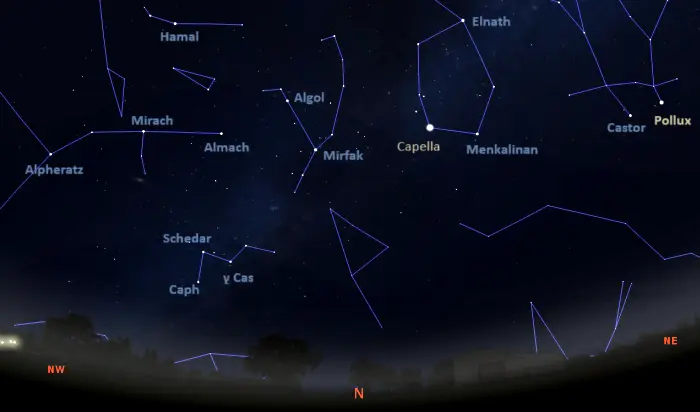
Stars in the northern sky tonight in equatorial latitudes, image: Stellarium
Cassiopeia (the Queen) appears lower in the sky and its W asterism looks like an M around 10 pm. The familiar pattern is formed by the constellation’s five brightest stars, three of which shine at second magnitude.
The constellations Cassiopeia and Perseus are linked by the myth of Andromeda, a princess left chained to a rock and rescued by Perseus from the Sea Monster (Cetus). They appear in the same region of the sky as Andromeda.
Andromeda’s most identifiable feature is a relatively straight line of three bright stars – Alpheratz, Mirach and Almach – that begins at the Great Square of Pegasus. Alpheratz is part of the Great Square asterism, which represents the body of Pegasus. Alpheratz and Mirach are equally bright and Almach is imperceptibly (to the human eye) fainter.
The stars of Andromeda can be used to locate the fainter constellation Triangulum (the Triangle). The brighter Aries (the Ram) appears just above the celestial Triangle in the evening. The constellation’s brightest star, the orange giant Hamal, shines at magnitude 2.0 from a distance of 65.8 light-years. It is, on average, the 50th brightest star in the sky.
Eastern sky
The stars of the Winter Circle dominate the eastern and northeastern sky. The bright asterism is formed by six first-magnitude stars: Rigel in Orion, Sirius in Canis Major, Procyon in Canis Minor, Pollux in Gemini, Capella in Auriga, and Aldebaran in Taurus.
The red supergiant Betelgeuse is the brightest star within the hexagon-shaped asterism. It forms the Winter Triangle (or the Great Southern Triangle) with Sirius and Procyon.
Sirius, the Dog Star, is the brightest star in the sky. It is the only one of the five brightest stars in Canis Major that will not go out as a supernova. Its bright giant neighbours Mirzam and Adhara and supergiants Wezen and Aludra are all massive enough to be supernova candidates. These stars lie hundreds or thousands of light years away. Sirius, on the other hand, lies only 8.61 light-years away and is one of our closest neighbours.
The constellation Orion (the Hunter) also hosts many supernova candidates. Among its eight brightest stars, only Bellatrix at the Hunter’s shoulder may not have such a spectacular demise. The red supergiant Betelgeuse – the only red star in the group – and the blue supergiants Rigel, Saiph, Alnitak, Alnilam, Mintaka, and Meissa (the star that marks Orion’s head) all have over 15 times the Sun’s mass, which seals their fate.
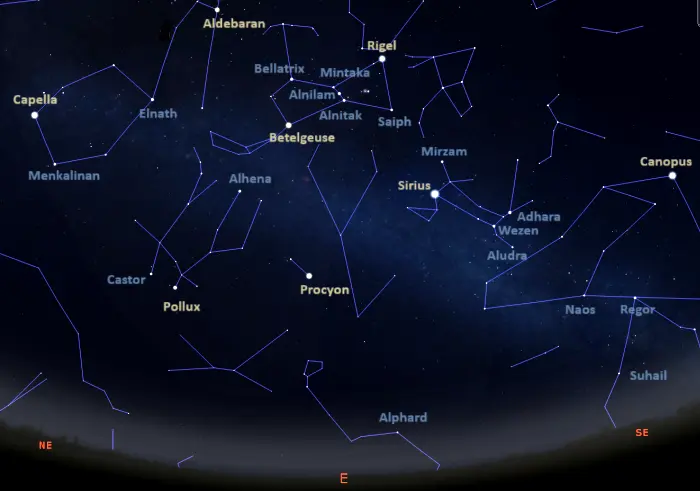
Stars in the eastern sky tonight in equatorial latitudes, image: Stellarium
Like Sirius, Procyon lies in the Sun’s neighbourhood, only 11.46 light-years away. It is the brightest star in Canis Minor and the eighth brightest star in the sky. Both Sirius and Procyon have white dwarf companions, long-gone stars that evolved faster than their binary companions and ended their lives by casting off their outer layers.
Pollux and Castor mark the heads of the Twins represented by the constellation Gemini. The two stars appear in the northeastern sky. Pollux is closer to Procyon and Castor to Capella. They appear very similar, but they could not be more different. Castor is a hot A-type main sequence star in a sextuple star system, while Pollux is a cool K-type giant that has already entered the last stages of its life cycle.
Alphard, another K-type giant, appears low above the eastern horizon. It is the brightest star in the otherwise faint constellation Hydra. It has an apparent magnitude of 2.0 and lies about 177 light-years away.
Naos, the luminary of the constellation Puppis, appears in the southeastern sky. While it shines at a modest second magnitude, it is one of the most luminous stars visible to the unaided eye. The blue O-type supergiant lies approximately 1,080 light-years away and has a luminosity 446,700 times that of the Sun.
Western sky
There are no first or second magnitude stars appearing directly west in the evening. The bright Fomalhaut sets in the southwestern sky after 10 pm and the stars of Pegasus lie toward the northwest.
Fomalhaut, the 18th brightest star in the sky, is the brightest point of light in the constellation Piscis Austrinus (the Southern Fish). It marks the mouth of the Southern Fish. The A-type dwarf lies about 25 light-years away and is part of a triple star system whose faintest component lies in the neighbouring constellation Aquarius (the Water Bearer).
Fomalhaut appears isolated in this area of the sky, with no other first or second magnitude stars in the immediate vicinity. The star can be found using the Great Square of Pegasus, a bright quadrilateral star pattern that dominates the constellation Pegasus. A line drawn from the western side of the Great Square across the sky leads to Fomalhaut.
A line extended from the eastern stars of the Great Square points in the general direction of Diphda, the brightest star in Cetus (the Sea Monster). Diphda lies just east of the imaginary line and is the only relatively bright star in this area of the sky. The orange giant lies 96.3 light-years away in the tail of the celestial Sea Monster.
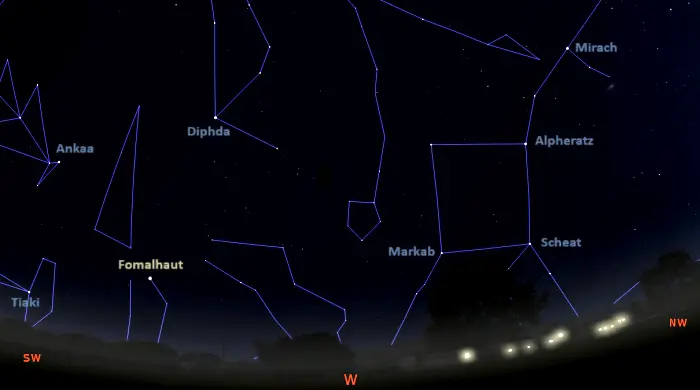
Stars in the western sky tonight in equatorial latitudes, image: Stellarium
The Great Square of Pegasus is formed by Alpheratz in the constellation Andromeda with Scheat, Markab and Algenib in Pegasus. Alpheratz historically belonged to both constellations (Andromeda and Pegasus) but is now assigned only to Andromeda. However, its name is a reference to Pegasus. It is derived from an Arabic phrase meaning “the navel of the mare/horse.” Alpheratz is a B-type subgiant star with 3.63 times the Sun’s mass, located 97 light-years away.
Scheat, Markab and Algenib are the second, third and fourth brightest stars in Pegasus, respectively. The constellation’s luminary, the orange supergiant Enif, sets earlier in the evening.
Like Alpheratz, Scheat, Markab and Algenib are evolved stars. Scheat is a red giant or bright giant located 196 light-years away. It has a mass of 1.7 solar masses and has expanded to a size of 109 solar radii. Markab is an evolved blue-white star about 133 light-years away. It has 3.5 times the Sun’s mass and a luminosity of 165 Suns.
Algenib, the faintest star of the Great Square, is also the most distant. It is a hot blue subgiant star located 470 light-years away. It has a mass 8.8 times that of the Sun and shines with 6,000 solar luminosities. It is the most intrinsically luminous star in the Great Square but due to its distance it shines just below second magnitude.
Southern sky
The brightest stars in the southern sky in the evening are Canopus and Achernar, the second and ninth brightest stars in the sky. They appear in the southeast and southwest.
Canopus is a young A-type bright giant located 310 light-years away. Unlike the brighter Sirius, Canopus appears so bright because it is intrinsically luminous. It has an energy output of 16,600 Suns and was the brightest star in Earth’s sky three times in the past four million years. Sirius took over about 90,000 years ago, when it came close enough to the Sun to outshine Canopus. When it moves away again in 480,000 years, Canopus will once again be the brightest star.
Canopus is the brightest star in the constellation Carina, which represents the Keel of the ship Argo in Greek mythology. The constellations representing the ship’s Sails (Vela) and Stern (Puppis) are also visible in the southeastern sky in the evening.
Avior and Aspidiske in Carina form an asterism known as the False Cross with Alsephina and Markeb in Vela. The asterism is larger but fainter than the Southern Cross and observers often mistake one for the other.
Alsephina is the only one of the four stars of the False Cross that is still on the main sequence. It is an A-type main sequence star in a triple star system located 80.6 light-years away. Its name comes from the Arabic word for “the ship.” The fainter Markeb is a hot blue subgiant located 570 light-years away. With a mass of 13 solar masses, it is a supernova candidate.
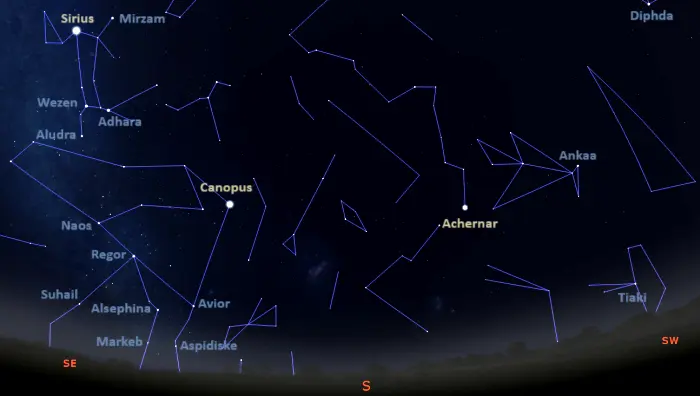
Stars in the southern sky tonight in equatorial latitudes, image: Stellarium
Avior will also have a spectacular end. It is an orange giant with a mass 10.5 times that of the Sun, located 610 light-years away. Aspidiske, the only supergiant in the group, shines with a luminosity 4,900 times that of the Sun from a distance of 770 light-years.
Achernar, the luminary of the celestial River (Eridanus), is high above the horizon in the evening. The fast-spinning hot blue star lies 139 light-years away and marks the River’s end. It is the hottest and bluest of the 10 brightest stars in the sky. Due to its high spin rate, Achernar has an oblate shape, with flattened poles and an equatorial bulge. It forms a binary system with a fainter A-type main sequence star.
Ankaa and Tiaki in the Southern Birds constellations Phoenix and Grus are visible above the southwestern horizon. Both are evolved red giant stars much more luminous than the Sun. Ankaa is the brightest star in Phoenix and Tiaki is the second brightest star in Grus (the Crane). Alnair, the brightest star in Grus, sets before 10 pm.
Southern hemisphere
The brightest star near the zenith in the evening is Achernar, the lucida of the celestial River (Eridanus). The hot blue star is one of the fastest spinners visible to the unaided eye. It has a projected rotational velocity of 250 km/s. As a result, it has an oblate shape, and its poles are hotter and brighter than its equator.
Achernar marks the end of the River, while Cursa, the second brightest star in Eridanus, marks its beginning. Eridanus stretches farther from north to south than any other constellation. Cursa appears near Rigel in the equatorial constellation Orion, while Achernar lies in the far southern sky.
Fomalhaut, the brightest star in Piscis Austrinus (the Southern Fish) appears high in the western sky and Canopus, the luminary of Carina (the Keel) is high in the southeast. Sirius, the brightest star in the sky, appears directly east in the evening, while Betelgeuse, Rigel and Aldebaran lie in the northeastern sky.
The southern sky is dominated by the Southern Pointers and the Southern Cross. The Southern Pointers, Rigil Kentaurus and Hadar (Alpha and Beta Centauri) point toward Gacrux at the top of the Southern Cross. Acrux and Mimosa, the brightest stars of Crux, are the 13th and 20th brightest stars in the sky, while Alpha and Beta Centauri are the third and 11th brightest stars.
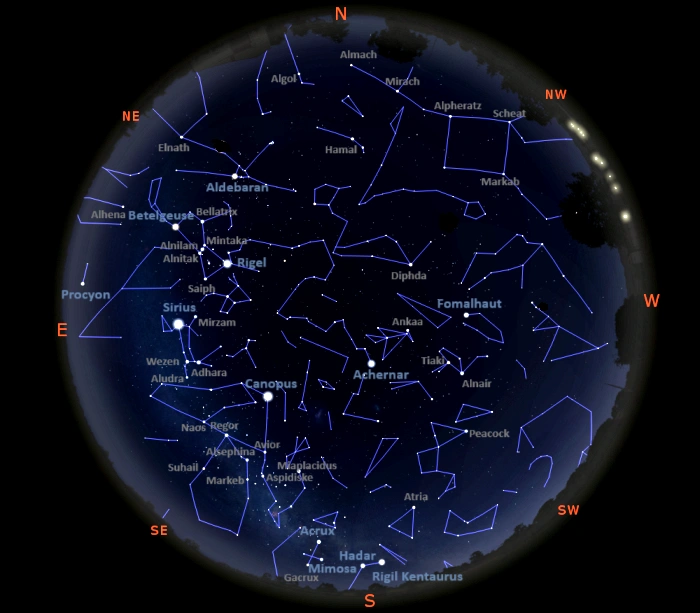
Stars visible tonight in the southern hemisphere, image: Stellarium
Northern sky
The bright stars of Perseus, Andromeda and Aries appear above the northern horizon in the evening. Aldebaran and Elnath in Taurus appear high in the northeast and the stars of Pegasus dominate the northwestern sky.
Alpheratz, Mirach and Almach, the brightest stars in the constellation Andromeda, form a distinctive line that is easily visible above the northern and northwestern horizon. The variable red giant Mirach, the middle of the three stars, is usually imperceptibly brighter than the other two. It has a luminosity of 1,675 Suns and lies 197 light-years away.
Mirach is very well-known to stargazers because it can be used to find the Andromeda Galaxy (M31) and the Triangulum Galaxy (M33), the most distant deep sky objects visible to the unaided eye (in exceptionally good conditions).
The fainter Almach is part of a multiple star system located approximately 390 light-years away. It is an evolved K-type bright giant that shines with 2,987 solar luminosities. The star can be used to find the bright open clusters Messier 34 and NGC 752, and the unbarred spiral galaxy NGC 891 (Caldwell 23), popularly known as the Silver Sliver Galaxy or the Outer Limits Galaxy. The galaxy and the star cluster M34 appear in the region between Almach and the eclipsing variable star Algol in Perseus.
Alpheratz is part of the Great Square of Pegasus, an asterism that forms the body of the celestial Winged Horse. The star is a hot blue B-type subgiant 158 times more luminous than the Sun, located about 97 light-years away. A line extended from Alpheratz through Algenib, the faintest star of the Great Square, points roughly in the direction of Diphda, the brightest star in the constellation Cetus (the Sea Monster or the Whale). The giant star marks the Sea Monster’s tail.
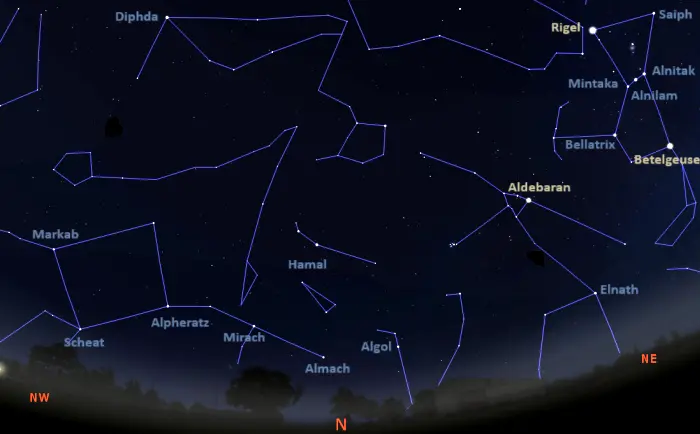
Stars in the northern sky tonight in the southern hemisphere, image: Stellarium
Algol and Mirach form a triangle with the K-type giant Hamal, the brightest star in the constellation Aries. Hamal is part of a flat triangle that makes the Ram constellation recognizable. The star appears near the fainter elongated triangle that gives the constellation Triangulum its name.
Aldebaran, the brightest star in Taurus and the 14th brightest star in the sky, appears high above the northeastern horizon. The K-type red giant lies 67 light-years away, in the same line of sight as the more distant Hyades (153 ly). The star and the bright open cluster outline the V-shaped head of the celestial Bull. Aldebaran marks one of the Bull’s eyes and Ain, one of the brightest Hyades stars, marks the other.
Aldebaran and the Hyades are found along the imaginary line extended from the three bright stars of Orion’s Belt, which appear in the northeastern sky in the evening.
Elnath, the second brightest star in Taurus, lies closer to the northeastern horizon around 10 pm. The hot blue giant star is part of Auriga’s hexagon, an asterism formed by the brightest stars in the constellation Auriga. Capella, Menkalinan and other stars of the hexagon rise later in the evening.
Elnath marks the Bull’s northern horn. The fainter Tianguan marks the southern. Tianguan can be used to find the famous Crab Nebula, a bright supernova remnant listed and the first object (Messier 1) in Charles Messier’s catalogue.
Eastern sky
Sirius and Canopus, the brightest stars in the sky, appear in the eastern and southeastern sky in the evening. They are the brightest stars in the constellations Canis Major (the Great Dog) and Carina (the Keel).
Sirius lies almost directly east around 10 pm. It is the only bright star in Canis Major that will not go out as a supernova at some point in the future. It appears so bright mainly because it lies only 8.61 light-years away.
The four second-magnitude stars in the Great Dog constellation – Adhara, Wezen, Mirzam, and Aludra – are much more massive, intrinsically luminous, and more distant. The hot B-type giant or bright giant Mirzam lies 490 light-years away and has a mass 13 times that of the Sun. The B-type bright giant Adhara has 13.1 times the Sun’s mass and lies approximately 405 light-years away. The F-type supergiant Wezen has a mass of 14-15 solar masses and lies at a distance of 1,600 light-years, while the hot blue B-type supergiant Aludra lies approximately 2,000 light-years away. It has a mass 5.5 or 9.5 times that of the Sun and a luminosity of 163,800 Suns. Adhara, Wezen and Aludra form a conspicuous triangle that appears right of Sirius in the evening.
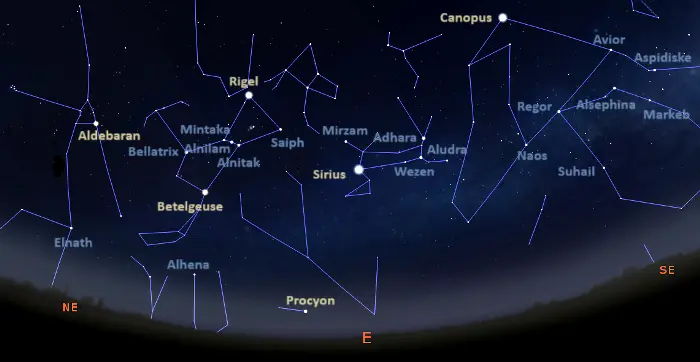
Stars in the eastern sky tonight in the southern hemisphere, image: Stellarium
Procyon, the brightest star in Canis Minor and the eighth brightest star in the sky, lies only 11.46 light-years away. It appears close to the eastern horizon and forms a bright triangle with Sirius and Betelgeuse.
The stars of Orion are prominent in the northeastern sky. They form a crooked hourglass asterism that makes the celestial Hunter easily recognizable. Almost all seven of the constellation’s brightest stars are destined to go out as supernovae when they reach the end of their life cycles. Only the fate of Bellatrix is uncertain. The star has a mass close to the threshold for a supernova candidate, but it may instead end its life as a massive white dwarf.
Rigel, Betelgeuse and Bellatrix, the three brightest stars of Orion, are the seventh, 10th and 26th brightest stars in the sky, while the stars of Orion’s Belt – Alnilam, Alnitak and Mintaka – are the 29th, 31st and 73rd brightest stars, respectively. Rigel, Alnilam and Saiph are hot blue B-type supergiants, and Alnitak is a hotter O-type supergiant. Betelgeuse is a red supergiant and the only distinctly red star in the group. Mintaka is an O-type bright giant, and Bellatrix has the spectrum of a B-type giant but may still be on the main sequence.
Naos, the brightest star in the constellation Puppis, is another exceptionally hot and luminous star visible in the evening. It appears high in the southeastern sky. It is an O-type supergiant with a mass 25.3 times that of the Sun and a luminosity of up to 446,700 Suns. The star lies approximately 1,080 light-years away. Its name comes from the Greek word for “ship.”
Western sky
Fomalhaut is the brightest star in the western sky. The star marks the mouth of the Southern Fish (Piscis Austrinus), into which the Water Bearer (Aquarius) is pouring water. Fomalhaut can be identified using the stars of the Great Square of Pegasus. A line extended from Scheat through Markab points towards it. Shining at magnitude 1.16, Fomalhaut is the 18th brightest star in the sky.
Alnair and Tiaki (Alpha and Beta Gruis) appear just left of Fomalhaut in the evening. The brighter Alnair, the brightest star in the constellation Grus (the Crane) is a hot blue B-type star located 101 light-years away. Tiaki is a red giant that lies 177 light-years away.
The stars of Pegasus are prominent above the northwestern horizon. Scheat, Markab and Algenib form the Square of Pegasus with Alpheratz in the constellation Andromeda. The asterism represents the main body of Pegasus.
All four stars of the Great Square have evolved away from the main sequence. Alpheratz and Algenib are hot blue B-type subgiants, Markab is an A-type subgiant, and Scheat is a red giant or bright giant.
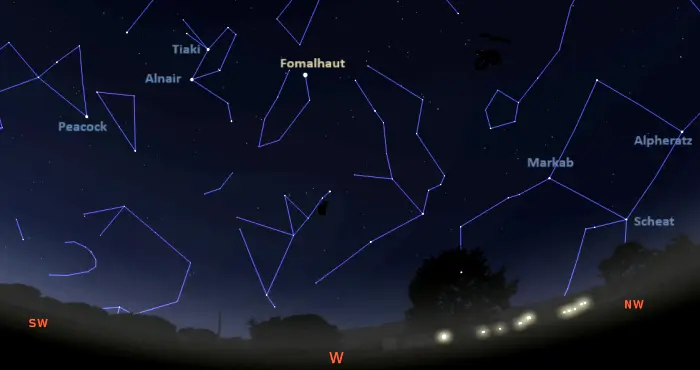
Stars in the western sky tonight in the southern hemisphere, image: Stellarium
Southern sky
Four first-magnitude stars appear low above the southern horizon in the evening. The Southern Pointers Alpha and Beta Centauri (Rigil Kentaurus and Hadar) appear almost directly south. They are the brightest points of light in the constellation Centaurus and the third and 11th brightest stars in the sky. A line extended from Rigil Kentaurus through Hadar points towards the second-magnitude red giant Gacrux, the star that marks the top of the Southern Cross.
Acrux and Mimosa, the brightest stars in the constellation Crux, are the 13th and 20th brightest stars in the sky, while Gacrux is the 25th brightest star. Acrux, Mimosa and the fainter Imai are all hot, luminous B-type stars. Mimosa is a giant star and Acrux and Imai are subgiants. They belong to the same family; they formed in the same molecular cloud at around the same time. In contrast, Gacrux is a cooler red giant and Ginan, the faintest star of the Southern Cross, is an orange K-type giant.
The bright Atria, the luminary of Triangulum Australe (the Southern Triangle) is easily visible near Alpha and Beta Centauri, and the luminaries of Pavo (the Peacock) and Grus (the Crane) appear high in the southwest. Atria is a K-type bright giant or supergiant 4,634 times more luminous than the Sun. It lies approximately 390 light-years away.
Peacock, the brightest star in Pavo, takes its name from its host constellation. The hot blue B-type star shines with a luminosity of 2,200 Suns from a distance of 179 light-years.
The stars of the obsolete constellation Argo Navis occupy much of the southeastern sky. Canopus, the second brightest star in the sky, easily stands out. The white bright giant shines at magnitude -0.74 from a distance of 310 light-years. It has 9-10 times the Sun’s mass and is 16,600 times more luminous than our parent star.
Canopus is one of three navigational stars in the constellation Carina, which represents the Keel of Argo Navis (the Ship Argo). The other two, Miaplacidus and Avior, appear lower in the sky.
Miaplacidus, a white giant, forms the Diamond Cross with the fainter Theta, Upsilon and Omega Carinae, while Avior forms the False Cross with Aspidiske in Carina and Alsephina and Markeb in the neighbouring constellation Vela (the Sails).
The three diamond-shaped asterisms – the Southern Cross, the False Cross, and the Diamond Cross – are often mistaken for one another. The Southern Cross is commonly used to find true south. It is the brightest of the three asterisms and appears near the exceptionally bright Rigil Kentaurus and Hadar. The Diamond Cross appears roughly halfway between Canopus and Rigil Kentaurus, the second and third brightest stars in the sky, and the False Cross appears directly below Canopus in the evening.
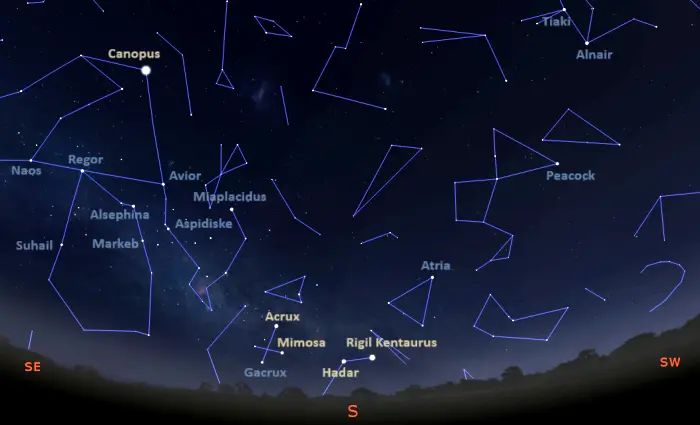
Stars in the southern sky tonight in the southern hemisphere, image: Stellarium